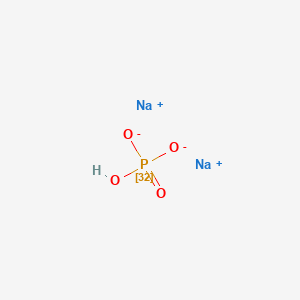
Thiamine
Descripción general
Descripción
La tiamina, también conocida como vitamina B1, es una vitamina soluble en agua que es esencial para la salud humana. Fue la primera vitamina B en ser descubierta y desempeña un papel crucial en el metabolismo de los carbohidratos, las grasas y las proteínas. La tiamina se encuentra en varios alimentos, incluidos los cereales integrales, las legumbres y algunas carnes y pescados. También se sintetiza comercialmente para su uso como suplemento dietético y medicamento .
Métodos De Preparación
Rutas Sintéticas y Condiciones de Reacción: La tiamina se puede sintetizar a través de varias rutas químicas. Un método común implica la reacción de 4-metil-5-(2-hidroxietil)tiazol con 2-metil-4-amino-5-clorometilpirimidina en condiciones básicas para formar tiamina . La reacción generalmente requiere un solvente como el metanol y una base como el hidróxido de sodio.
Métodos de Producción Industrial: En entornos industriales, la clorhidrato de tiamina se produce a menudo mediante la reacción de nitrato de tiamina con ácido clorhídrico. El proceso implica calentar ácido clorhídrico concentrado, enfriar y secar el gas cloruro de hidrógeno desorbido y luego introducirlo en una solución metanólica de nitrato de tiamina. El clorhidrato de tiamina resultante se filtra, se lava y se seca .
Análisis De Reacciones Químicas
Tipos de Reacciones: La tiamina experimenta diversas reacciones químicas, que incluyen:
Oxidación: La tiamina se puede oxidar para formar tiocroma, un compuesto fluorescente utilizado en química analítica.
Fosforilación: La tiamina se fosforila para formar pirofosfato de tiamina, una coenzima esencial en las reacciones metabólicas.
Reactivos y Condiciones Comunes:
Oxidación: El ferricianuro de potasio se usa comúnmente como agente oxidante para convertir la tiamina en tiocroma.
Fosforilación: La tiamina se fosforila mediante la tiamina pirofosfoquinasa en presencia de trifosfato de adenosina (ATP).
Principales Productos:
Tiocroma: Formado a través de la oxidación de la tiamina.
Pirofosfato de Tiamina: Formado a través de la fosforilación de la tiamina.
Aplicaciones Científicas De Investigación
Mecanismo De Acción
La tiamina ejerce sus efectos principalmente a través de su forma activa, el pirofosfato de tiamina. Esta coenzima está involucrada en varias vías metabólicas clave, incluida la descarboxilación del ácido pirúvico y los alfa-cetoácidos. El pirofosfato de tiamina actúa como cofactor para enzimas como la transcetolasa, la piruvato deshidrogenasa y la alfa-cetoglutarato deshidrogenasa, que son cruciales para la producción de energía y la síntesis de ácidos nucleicos y ácidos grasos .
Compuestos Similares:
Benfotiamina: Un derivado liposoluble de la tiamina que tiene una mayor biodisponibilidad y se utiliza para tratar la neuropatía diabética.
Monofosfato de Tiamina: Una forma fosforilada de la tiamina que sirve como intermedio en la síntesis de pirofosfato de tiamina.
Trifosfato de Tiamina: Otra forma fosforilada de la tiamina involucrada en el metabolismo energético celular.
Singularidad: La tiamina es única entre sus compuestos similares debido a su papel como precursor principal del pirofosfato de tiamina, la forma coenzimática activa. Si bien la benfotiamina y otros derivados tienen aplicaciones y ventajas específicas, la tiamina en sí es esencial para una amplia gama de procesos metabólicos y es la forma más utilizada en los suplementos dietéticos y los alimentos fortificados .
Comparación Con Compuestos Similares
Benfotiamine: A lipid-soluble derivative of thiamine that has higher bioavailability and is used to treat diabetic neuropathy.
This compound Monophosphate: A phosphorylated form of this compound that serves as an intermediate in the synthesis of this compound pyrophosphate.
This compound Triphosphate: Another phosphorylated form of this compound involved in cellular energy metabolism.
Uniqueness: this compound is unique among its similar compounds due to its role as the primary precursor for this compound pyrophosphate, the active coenzyme form. While benfotiamine and other derivatives have specific applications and advantages, this compound itself is essential for a wide range of metabolic processes and is the most commonly used form in dietary supplements and fortified foods .
Propiedades
IUPAC Name |
2-[3-[(4-amino-2-methylpyrimidin-5-yl)methyl]-4-methyl-1,3-thiazol-3-ium-5-yl]ethanol | |
|---|---|---|
| Source | PubChem | |
| URL | https://pubchem.ncbi.nlm.nih.gov | |
| Description | Data deposited in or computed by PubChem | |
InChI |
InChI=1S/C12H17N4OS/c1-8-11(3-4-17)18-7-16(8)6-10-5-14-9(2)15-12(10)13/h5,7,17H,3-4,6H2,1-2H3,(H2,13,14,15)/q+1 | |
| Source | PubChem | |
| URL | https://pubchem.ncbi.nlm.nih.gov | |
| Description | Data deposited in or computed by PubChem | |
InChI Key |
JZRWCGZRTZMZEH-UHFFFAOYSA-N | |
| Source | PubChem | |
| URL | https://pubchem.ncbi.nlm.nih.gov | |
| Description | Data deposited in or computed by PubChem | |
Canonical SMILES |
CC1=C(SC=[N+]1CC2=CN=C(N=C2N)C)CCO | |
| Source | PubChem | |
| URL | https://pubchem.ncbi.nlm.nih.gov | |
| Description | Data deposited in or computed by PubChem | |
Molecular Formula |
C12H17N4OS+ | |
| Source | PubChem | |
| URL | https://pubchem.ncbi.nlm.nih.gov | |
| Description | Data deposited in or computed by PubChem | |
DSSTOX Substance ID |
DTXSID50220251 | |
| Record name | Thiamine ion | |
| Source | EPA DSSTox | |
| URL | https://comptox.epa.gov/dashboard/DTXSID50220251 | |
| Description | DSSTox provides a high quality public chemistry resource for supporting improved predictive toxicology. | |
Molecular Weight |
265.36 g/mol | |
| Source | PubChem | |
| URL | https://pubchem.ncbi.nlm.nih.gov | |
| Description | Data deposited in or computed by PubChem | |
Physical Description |
Solid with a slight odor; [HSDB] Crystals; [Avocado Research MSDS], Solid | |
| Record name | Thiamine | |
| Source | Haz-Map, Information on Hazardous Chemicals and Occupational Diseases | |
| URL | https://haz-map.com/Agents/17375 | |
| Description | Haz-Map® is an occupational health database designed for health and safety professionals and for consumers seeking information about the adverse effects of workplace exposures to chemical and biological agents. | |
| Explanation | Copyright (c) 2022 Haz-Map(R). All rights reserved. Unless otherwise indicated, all materials from Haz-Map are copyrighted by Haz-Map(R). No part of these materials, either text or image may be used for any purpose other than for personal use. Therefore, reproduction, modification, storage in a retrieval system or retransmission, in any form or by any means, electronic, mechanical or otherwise, for reasons other than personal use, is strictly prohibited without prior written permission. | |
| Record name | Thiamine | |
| Source | Human Metabolome Database (HMDB) | |
| URL | http://www.hmdb.ca/metabolites/HMDB0000235 | |
| Description | The Human Metabolome Database (HMDB) is a freely available electronic database containing detailed information about small molecule metabolites found in the human body. | |
| Explanation | HMDB is offered to the public as a freely available resource. Use and re-distribution of the data, in whole or in part, for commercial purposes requires explicit permission of the authors and explicit acknowledgment of the source material (HMDB) and the original publication (see the HMDB citing page). We ask that users who download significant portions of the database cite the HMDB paper in any resulting publications. | |
Solubility |
500.0 mg/mL | |
| Record name | Thiamine | |
| Source | DrugBank | |
| URL | https://www.drugbank.ca/drugs/DB00152 | |
| Description | The DrugBank database is a unique bioinformatics and cheminformatics resource that combines detailed drug (i.e. chemical, pharmacological and pharmaceutical) data with comprehensive drug target (i.e. sequence, structure, and pathway) information. | |
| Explanation | Creative Common's Attribution-NonCommercial 4.0 International License (http://creativecommons.org/licenses/by-nc/4.0/legalcode) | |
| Record name | Thiamine | |
| Source | Human Metabolome Database (HMDB) | |
| URL | http://www.hmdb.ca/metabolites/HMDB0000235 | |
| Description | The Human Metabolome Database (HMDB) is a freely available electronic database containing detailed information about small molecule metabolites found in the human body. | |
| Explanation | HMDB is offered to the public as a freely available resource. Use and re-distribution of the data, in whole or in part, for commercial purposes requires explicit permission of the authors and explicit acknowledgment of the source material (HMDB) and the original publication (see the HMDB citing page). We ask that users who download significant portions of the database cite the HMDB paper in any resulting publications. | |
Mechanism of Action |
It is thought that the mechanism of action of thiamine on endothelial cells is related to a reduction in intracellular protein glycation by redirecting the glycolytic flux. Thiamine is mainly the transport form of the vitamin, while the active forms are phosphorylated thiamine derivatives. Natural derivatives of thiamine phosphate, such as thiamine monophosphate (ThMP), thiamine diphosphate (ThDP), also sometimes called thiamine pyrophosphate (TPP), thiamine triphosphate (ThTP), and thiamine triphosphate (AThTP), that act as coenzymes in addition to their each unique biological functions. | |
| Record name | Thiamine | |
| Source | DrugBank | |
| URL | https://www.drugbank.ca/drugs/DB00152 | |
| Description | The DrugBank database is a unique bioinformatics and cheminformatics resource that combines detailed drug (i.e. chemical, pharmacological and pharmaceutical) data with comprehensive drug target (i.e. sequence, structure, and pathway) information. | |
| Explanation | Creative Common's Attribution-NonCommercial 4.0 International License (http://creativecommons.org/licenses/by-nc/4.0/legalcode) | |
CAS No. |
70-16-6, 59-43-8 | |
| Record name | 3-[(4-Amino-2-methyl-5-pyrimidinyl)methyl]-5-(2-hydroxyethyl)-4-methylthiazolium | |
| Source | CAS Common Chemistry | |
| URL | https://commonchemistry.cas.org/detail?cas_rn=70-16-6 | |
| Description | CAS Common Chemistry is an open community resource for accessing chemical information. Nearly 500,000 chemical substances from CAS REGISTRY cover areas of community interest, including common and frequently regulated chemicals, and those relevant to high school and undergraduate chemistry classes. This chemical information, curated by our expert scientists, is provided in alignment with our mission as a division of the American Chemical Society. | |
| Explanation | The data from CAS Common Chemistry is provided under a CC-BY-NC 4.0 license, unless otherwise stated. | |
| Record name | Thiamine ion | |
| Source | ChemIDplus | |
| URL | https://pubchem.ncbi.nlm.nih.gov/substance/?source=chemidplus&sourceid=0000070166 | |
| Description | ChemIDplus is a free, web search system that provides access to the structure and nomenclature authority files used for the identification of chemical substances cited in National Library of Medicine (NLM) databases, including the TOXNET system. | |
| Record name | Thiamine | |
| Source | DrugBank | |
| URL | https://www.drugbank.ca/drugs/DB00152 | |
| Description | The DrugBank database is a unique bioinformatics and cheminformatics resource that combines detailed drug (i.e. chemical, pharmacological and pharmaceutical) data with comprehensive drug target (i.e. sequence, structure, and pathway) information. | |
| Explanation | Creative Common's Attribution-NonCommercial 4.0 International License (http://creativecommons.org/licenses/by-nc/4.0/legalcode) | |
| Record name | Thiamine ion | |
| Source | EPA DSSTox | |
| URL | https://comptox.epa.gov/dashboard/DTXSID50220251 | |
| Description | DSSTox provides a high quality public chemistry resource for supporting improved predictive toxicology. | |
| Record name | Thiamine | |
| Source | European Chemicals Agency (ECHA) | |
| URL | https://echa.europa.eu/substance-information/-/substanceinfo/100.000.387 | |
| Description | The European Chemicals Agency (ECHA) is an agency of the European Union which is the driving force among regulatory authorities in implementing the EU's groundbreaking chemicals legislation for the benefit of human health and the environment as well as for innovation and competitiveness. | |
| Explanation | Use of the information, documents and data from the ECHA website is subject to the terms and conditions of this Legal Notice, and subject to other binding limitations provided for under applicable law, the information, documents and data made available on the ECHA website may be reproduced, distributed and/or used, totally or in part, for non-commercial purposes provided that ECHA is acknowledged as the source: "Source: European Chemicals Agency, http://echa.europa.eu/". Such acknowledgement must be included in each copy of the material. ECHA permits and encourages organisations and individuals to create links to the ECHA website under the following cumulative conditions: Links can only be made to webpages that provide a link to the Legal Notice page. | |
| Record name | THIAMINE ION | |
| Source | FDA Global Substance Registration System (GSRS) | |
| URL | https://gsrs.ncats.nih.gov/ginas/app/beta/substances/4ABT0J945J | |
| Description | The FDA Global Substance Registration System (GSRS) enables the efficient and accurate exchange of information on what substances are in regulated products. Instead of relying on names, which vary across regulatory domains, countries, and regions, the GSRS knowledge base makes it possible for substances to be defined by standardized, scientific descriptions. | |
| Explanation | Unless otherwise noted, the contents of the FDA website (www.fda.gov), both text and graphics, are not copyrighted. They are in the public domain and may be republished, reprinted and otherwise used freely by anyone without the need to obtain permission from FDA. Credit to the U.S. Food and Drug Administration as the source is appreciated but not required. | |
| Record name | Thiamine | |
| Source | Human Metabolome Database (HMDB) | |
| URL | http://www.hmdb.ca/metabolites/HMDB0000235 | |
| Description | The Human Metabolome Database (HMDB) is a freely available electronic database containing detailed information about small molecule metabolites found in the human body. | |
| Explanation | HMDB is offered to the public as a freely available resource. Use and re-distribution of the data, in whole or in part, for commercial purposes requires explicit permission of the authors and explicit acknowledgment of the source material (HMDB) and the original publication (see the HMDB citing page). We ask that users who download significant portions of the database cite the HMDB paper in any resulting publications. | |
Melting Point |
248 °C | |
| Record name | Thiamine | |
| Source | DrugBank | |
| URL | https://www.drugbank.ca/drugs/DB00152 | |
| Description | The DrugBank database is a unique bioinformatics and cheminformatics resource that combines detailed drug (i.e. chemical, pharmacological and pharmaceutical) data with comprehensive drug target (i.e. sequence, structure, and pathway) information. | |
| Explanation | Creative Common's Attribution-NonCommercial 4.0 International License (http://creativecommons.org/licenses/by-nc/4.0/legalcode) | |
| Record name | Thiamine | |
| Source | Human Metabolome Database (HMDB) | |
| URL | http://www.hmdb.ca/metabolites/HMDB0000235 | |
| Description | The Human Metabolome Database (HMDB) is a freely available electronic database containing detailed information about small molecule metabolites found in the human body. | |
| Explanation | HMDB is offered to the public as a freely available resource. Use and re-distribution of the data, in whole or in part, for commercial purposes requires explicit permission of the authors and explicit acknowledgment of the source material (HMDB) and the original publication (see the HMDB citing page). We ask that users who download significant portions of the database cite the HMDB paper in any resulting publications. | |
Retrosynthesis Analysis
AI-Powered Synthesis Planning: Our tool employs the Template_relevance Pistachio, Template_relevance Bkms_metabolic, Template_relevance Pistachio_ringbreaker, Template_relevance Reaxys, Template_relevance Reaxys_biocatalysis model, leveraging a vast database of chemical reactions to predict feasible synthetic routes.
One-Step Synthesis Focus: Specifically designed for one-step synthesis, it provides concise and direct routes for your target compounds, streamlining the synthesis process.
Accurate Predictions: Utilizing the extensive PISTACHIO, BKMS_METABOLIC, PISTACHIO_RINGBREAKER, REAXYS, REAXYS_BIOCATALYSIS database, our tool offers high-accuracy predictions, reflecting the latest in chemical research and data.
Strategy Settings
| Precursor scoring | Relevance Heuristic |
|---|---|
| Min. plausibility | 0.01 |
| Model | Template_relevance |
| Template Set | Pistachio/Bkms_metabolic/Pistachio_ringbreaker/Reaxys/Reaxys_biocatalysis |
| Top-N result to add to graph | 6 |
Feasible Synthetic Routes
Descargo de responsabilidad e información sobre productos de investigación in vitro
Tenga en cuenta que todos los artículos e información de productos presentados en BenchChem están destinados únicamente con fines informativos. Los productos disponibles para la compra en BenchChem están diseñados específicamente para estudios in vitro, que se realizan fuera de organismos vivos. Los estudios in vitro, derivados del término latino "in vidrio", involucran experimentos realizados en entornos de laboratorio controlados utilizando células o tejidos. Es importante tener en cuenta que estos productos no se clasifican como medicamentos y no han recibido la aprobación de la FDA para la prevención, tratamiento o cura de ninguna condición médica, dolencia o enfermedad. Debemos enfatizar que cualquier forma de introducción corporal de estos productos en humanos o animales está estrictamente prohibida por ley. Es esencial adherirse a estas pautas para garantizar el cumplimiento de los estándares legales y éticos en la investigación y experimentación.






![disodium;(6R,7R)-7-[[2-(2-amino-1,3-thiazol-4-yl)-2-methoxyiminoacetyl]amino]-3-[(2-methyl-6-oxido-5-oxo-1,2,4-triazin-3-yl)sulfanylmethyl]-8-oxo-5-thia-1-azabicyclo[4.2.0]oct-2-ene-2-carboxylate](/img/structure/B1217605.png)

![3,5-diacetamido-2,4,6-triiodo-N-methyl-N-[2-[methyl(2,3,4,5,6-pentahydroxyhexyl)amino]-2-oxoethyl]benzamide](/img/structure/B1217610.png)







